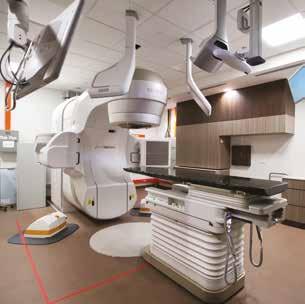
1 minute read
New and enhanced facilities at the NCCS building
l Goh Cheng Liang Proton Therapy Centre


The Goh Cheng Liang Proton Therapy Centre, which is supported by a $50 million gift from the Goh Foundation, offers proton therapy, an advanced type of radiation therapy. The Centre has four treatment gantries where proton therapy is delivered to patients. Proton therapy is an advanced radiation treatment that precisely targets and destroys cancer cells while minimising damage to surrounding healthy tissues and causing fewer side effects.
l Ambulatory Treatment Unit
In the Ambulatory Treatment Unit (ATU), robots are used to deliver prepared chemotherapy drugs from the oncology pharmacy to treatment suites, freeing up nurses to spend more time attending to patients. There are 108 recliner chairs and beds for patients who receive treatment in the treatment suites. In addition to its core role of delivering chemotherapy, procedures such as bone marrow aspiration and lumbar puncture are also performed at the ATU.
l Multidisciplinary Hubs l Cancer Discovery Hub
On clinic floors, multidisciplinary hubs are where healthcare teams convene to plan personalised care for their patients. Located behind the 64 consultation rooms, the multidisciplinary hubs provide space for medical, radiation and surgical oncologists to discuss with each other on care plans. Consultations, scans, biopsies and treatments are all located nearby or on the same floor to make visits more convenient and comfortable for patients.
The Cancer Discovery Hub (CDH) spearheads national-level initiatives on blood cancers, and supports biomarker discovery and clinical trials for breast and liver cancers. The CDH creates cell lines and 3D cancer models called organoids to facilitate high-impact research, and is also leading the setup of a national tumour organoid biobank. Assistant Professor Jason Chan, Director, CDH, cited a unique case, presented at a major cancer conference in the US earlier this year, of a pair of identical twins with a rare type of blood cancer treated at NCCS using advanced technologies at the CDH, such as single-cell sequencing and spatial profiling.










